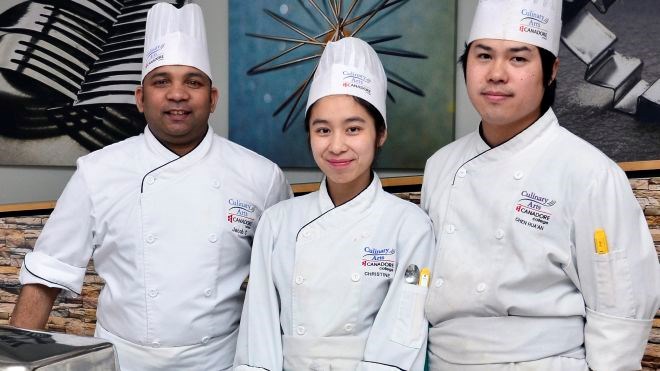At 100 Elements restaurant, the sophisticated array of ever-changing menu items, prompt service and high level of professionalism consistently position it among the top restaurants in North Bay on the travel review website TripAdvisor.
But what might come as a surprise to those not already familiar with the eatery is that it’s also a teaching restaurant for Canadore College’s culinary arts students – the hosts, servers and chefs are learning as they go.
David Himmelman, dean of media, arts, recreation and access at Canadore College, estimates about 100 students enrol annually across Canadore’s culinary arts programs, and demand in the field is growing, both for front-of-house service workers and back-of-house culinary workers.
“The estimates are that we will be probably about 25,000 jobs short over the next eight to 12 years (in the hospitality industry), so there are great opportunities,” Himmelman said. “I’d love to see more students than what we have right now.”
Canadore’s program is fairly small in comparison to its larger counterparts at schools like Toronto’s George Brown College or Niagara College, but studying in North Bay has its advantages.
“I think the reason we hear students love coming to our program is that interaction daily that they get with their chefs, people who have tremendous industry experience and who know them as individuals and not just a number in their class,” Himmelman said. “So it really is a personal experience in their time here.”
But despite 100 Elements being a learning environment, Shelley Busch, a culinary technologist at Canadore, said students aren’t let off the hook. While faculty and mentors do their best to guide their charges, learners still face the same demands they would in any other restaurant.
Patrons expect their orders to be accurate, the food to taste good, and the service to be quick and professional.
“We may nurture a little bit, but I work with three different chefs and, believe me, they’re out of the industry, and they treat the students the same as they would in the industry,” Busch said. “They have to work hard, they have to produce, and the pressure is on.”
The restaurant only operates during the school year, opening for dinner on Thursday and Friday nights and lunch on Tuesdays and Wednesdays. There are opportunities for learning across programs and skill levels, and students will rotate positions to ensure they experience the full scope of a job, Himmelman said.
There are plenty of opportunities to work special events in addition to the regular meal service; organizations regularly hold lunchtime meetings, Christmas parties, and mess dinners at the restaurant, and it’s often the site of the President’s Club Dinner, a fundraising initiative that raises money for scholarships and bursaries at the college.
“The second-year students do an international piece where they actually do recipe research, and we operate a chef’s table that seats anywhere from four to six people,” Busch said. “That table’s actually located right in the kitchen, and that menu changes weekly in the winter semester.”
Second-year students also must research and recreate a theme dinner, based on the work of a well-known chef, for a minimum of 50 guests. Toward the end of the semester, students must prepare and put on a large buffet meal.
The dinner service menu changes about three times per semester in an effort to both challenge the students with their advancing skills and to change it up for diners who return regularly.
“The chefs will start the first menu so that they’re using more basic skills, and then they advance to use more of the skills and processes that they have learned into the second and third menus that they get ready for,” Busch said.
“It's a learning experience, so we're tying this into our curriculum,” Himmelman added. “The chefs, when they're identifying that menu, they will make sure that whatever they're doing actually ties directly back to our curriculum.”
Many of the students enrolling in Canadore’s culinary arts programs are from Northern Ontario or smaller southern Ontario communities, Himmelman said, but a fair number of international students also study there.
In his 13 years there, Himmelman said he’s seen students from Mexico, China, the Caribbean and India pass through the school. They value the high-quality experience in a smaller setting that Canadore offers, he said.
“We’re not Toronto; we don’t purport to be Toronto,” he said. “But we give our students a lot of hands-on experience, maybe more sometimes than other institutions do, because we believe that that’s what they need to be prepared to go out into industry.”
Graduates have found success in a variety of settings. Some remain in North Bay, working in local establishments, while others have opened their own restaurants. Still others are lured abroad for work.
“Grads will either stay in the region or go away and return to the region later in their careers, because this has been a great place for them,” Himmelman said. “They’re living and working across Canada and all across the world.”




